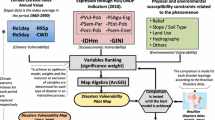Abstract
The relationship between political organization and hydraulic development is discussed, using illustrations from the Valley of Oaxaca, Mexico. It is suggested that change in political organization toward greater or lesser centralization of control over local water resource use may be part of a social response to environmental degradation (in this case, a receding water table) resulting from the effects of change in resource use (in this case, intensified water extraction). Economic stress due to environmental degradation varies in duration and intensity; such variations must be taken into account in understanding shifts in response patterns. Small-scale hydraulic development which places pressure on the availability of water for irrigation may elicit an initial response of centralization of control over its use to correct for the disturbance, water shortage. However, this response itself tends to exacerbate the disturbance through reducing previously existing homeostatic controls on the extraction of water and hence leads to greater economic stress, up to the point at which new responses must take place. Other kinds of environmental disturbance resulting from initial development attempts appear to have similar feedback effects which contribute to potential systemic instability.
Similar content being viewed by others
References
Adams, R. M. (1972). The Mesopotamian social landscape: A view from the frontier. Unpublished paper presented at the Cambridge Archeology Seminar Colloquium.
Barth, F. (1971).Nomads of South Persia, Oslo University Press, Oslo.
Cancian, F. (1965).Economics and Prestige in a Maya Comunity, Stanford University Press, Stanford, Calif.
Dirección General de Ingeniera Agricola (July 1968, September 1968, January 1969).Boletín Informativo de la Dirección General de Ingeniera Agricola, Nos. 1, 2, and 3, Secretaría de Agricultura y Ganadería, Mexico.
Farvar, H. T., and Milton, J. P. (1972).The Careless Technology, Natural History Press, New York.
Flannery, K. V. (1972). The cultural evolution of civilizations.Ann. Rev. Ecol. Systematics 3: 399–426.
Flannery, K. V., Kirkby, A., Kirkby, M., and Williams, A. (1967). Farming systems and political growth in ancient Oaxaca.Science 1958: 445–454.
Kearny, M. (1972).The Winds of Ixtepeji: World View and Society in a Zapotec Town, Holt, Rinehart and Winston, New York.
Kirkby, A. (1972). Perception of rainfall variability and agricultural and social adaptations to hazard by peasant cultivators in the Valley of Oaxaca, Mexico. Paper presented to Man and Environment Commission, 22nd International Geographical Congress, Calgary.
Lattimore, O. (1940).Inner Asian Frontiers of China, American Geographical Society of New York, New York.
Lees, S. (1973). Sociopolitical aspects of canal irrigation in the Valley of Oaxaca, Mexico.Oaxaca Reports, Vol. 3; University of Michigan Museum of Anthropology Memoir No. 6, University of Michigan Press, Ann Arbor.
Maruyama, M. (1963). The second cybernetics: Deviation-amplifying mutual causal processes.Am. Scientist 51: 164–179.
Millon, R., Hall, C., and Diaz, M. (1962). Variations in social responses to the practice of irrigation agriculture. In Woodbury (ed.),Civilization in Arid Lands, University of Utah Anthropological Papers No. 62, Provo, Utah.
Neely, J. (1967). Organización hidraulica y sistemas de irrigación prehistoricos en el Valle de Oaxaca.Bol Inst. Nac. Antropol. Hist. Mexico, No. 27.
Orlandini, R. (1967). A formative well from the Valley of Oaxaca. Paper presented at the 32nd Annual Meeting of the Society for American Archeology, Ann Arbor.
Sanders, W. T. (1965).The cultural ecology of the Teotihuacan Valley. Department of Sociology and Anthropology, Pennsylvania State University.
Steward, J. (1955). Some implications of the symposium. In Steward, J. (ed.),Irrigation Civilizations: A Comparative Study, Pan American Union Social Science Monograph No. 1, Washington, D.C.
UNESCO (1962).The Problems of the Arid Zone, Proceedings of the Paris Symposium (United Nations).
Wolf, E. (1955). Types of Latin American peasantry: A preliminary discussion.Amer. Anthropologist 57: 452–471.
Author information
Authors and Affiliations
Rights and permissions
About this article
Cite this article
Lees, S.H. Hydraulic development as a process of response. Hum Ecol 2, 159–175 (1974). https://doi.org/10.1007/BF01531419
Received:
Revised:
Issue Date:
DOI: https://doi.org/10.1007/BF01531419




